|
“I like that one!” a woman said as she scooted into the pew behind me. I agreed. In fact, when the friend of a friend of a friend offered me her mother’s hats, sending along a less-than-stellar cellphone picture, this white hat was the one that I was most excited and curious about. (The photo was so bad, one hat I took to be cello straw turned out to be velvet). I couldn’t quite tell this white hat's shape or material, but I loved the little embellishments. When I got the collection, which also included the Brown Wool Hat, the Red Breton, and the Black Hat with Scarf, I finally got a closer look at the hat. The milliner sewed on pearls and some long thin beads that were probably silver originally but tarnished over the years. The veil is in excellent shape, though it’s one of those long veils I’m never quite sure how to wear. For it to lie correctly it seems like I have to tie it. Yet, unwilling to harm the veil, I always tie it very loosely; it inevitably comes untied. I have other hats coming up with the same kinds of veils, so perhaps I’ll learn some tricks for wearing them before I wear them. Suggestions welcome! Return to the Hat Project main page.
0 Comments
This black hat was one of the hats given to me along with The Brown Wool Hat and The Red Breton. I initially didn’t take to it, because I thought it was too plain: a black hat with a thin black band. (Longtime readers will remember my unhappiness with the black-on-black Forgotten Hat). But then I thought, “Why not jazz it up with a pin or a scarf?” I tried this gold, red, and green scarf, and voila! I liked the hat much better. Though I accessorized this hat, I am not a milliner, any more than I am a jeweler. People sometimes ask me if I sewed a hat, or put the feather or flowers on it, or if I made a piece of jewelry. I answer no, that my talent is shopping. 😊 Of course, I can’t take credit for buying this hat, since it was a gift, and the pin was my grandmother’s (the same grandmother whose White Pillbox, Navy Pillbox, and Cello Straw hats I’ve previously worn). I can take credit for choosing the scarf, though, a William Morris print that I’ve had for years. My husband gets the credit for choosing the background for this photo, a bright mural gracing a downtown building. Return to The Hat Project main page.
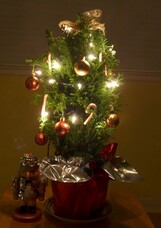 Kitchen remodel tree Kitchen remodel tree My first Christmas in my first apartment, I bought a tree so tall I had to cut the top off in order to stand it upright in the studio’s one room. That’s how enthusiastic (and clueless) I was, getting my first Christmas tree. I bought lights and more lights for it, distributed the few ornaments I had (gifts from my college roommates, inherited ones from my grandma Alma) and then bought more. I always have a Christmas tree, even when I’m going to be traveling for the holidays. I love the fir’s forest smell, the glow of the lights in a darkened room, the sparkle of ornaments in the sunshine. Though I’ve never again had a tree as big as that first one, I love the process of choosing and decorating a tree. I can reminisce looking at the ornaments—those from my roommates and my grandmother, those first sparkly glass pine cones I bought for myself, and also the mariachi man I bought on my honeymoon in Cancun, the nativity scene in a dried pomegranate from Budapest, the many ornaments given to me by loved ones through the years. A Christmas tree is a connection to my past, to all the years of decorating a tree as a child (even the scrawny living tree we had for years in the seventies), and as an adult. No matter how busy I am, I always want a fresh tree in the house for the holidays. The only year in memory that I failed to have one was the year we were remodeling our kitchen, with the kitchen contents crammed into boxes that took up half the living room. At the same time, we were in escrow on our new home, going through the inspections and repairs. I had to settle for a tabletop model (complete with ornaments and lights) from the grocery store floral department that year. 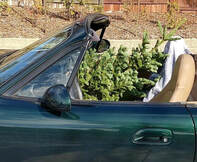 Miata-sized tree Miata-sized tree Even last year, when my husband was out of town, I still managed to bring home a tree in my Miata, a much smaller tree than my first tree, but just as beautiful. This red Breton (bumper?) seemed perfect for a tree-hunting expedition. This hat was one in the collection I got from Sandra that included the brown wool hat. Note that in this post originally, I had this down as a bowler, but I never felt comfortable with that identification. I think now it's more of a Breton, so I've changed the designation. Return to The Hat Project main page.
I recently realized that “hat lady” rhymes with “cat lady.” The way some people can’t resist a box labeled “Free Kittens,” I can’t resist a box of free hats. I want to give them a good home. I want them to be appreciated and worn. OK, I just want them. Several months ago, my friend Katheryn let me know that a friend of a friend was looking to donate a collection of hats that had been her mother’s. The woman, Sandra, hoped to give them to a local theater company, but hadn’t gotten any interest. Would I be interested? Free Kittens? Of course! We made connections, and soon Susan was pulling up in my driveway, passing off a box of hats. When I brought them inside and unpacked them, I discovered that they were all winter hats, made of wool and velvet. Some were probably from the early sixties, and some might be more recent (perhaps as late as the eighties). Hats are difficult to date, especially classic hat shapes without labels inside. Like my grandmother’s hats, these hats were in basic colors, but those basics included bright red, as well as black and white. Among the black, white, and red hats was this one brown hat. I’m guessing it’s from the sixties based on its shape, veil, and union label, but I don’t know for sure. I thought this would be a perfect hat for a fall day along with the vintage Pendelton coat given to me by my friend and fellow JewelTone Jeanne. And where did I wear it, besides around town to take pictures? I went to Bruce Munro's Field of Light installation. Back to The Hat Project main page.
I was jonesing for a new hat. I had started The Hat Project a month or two previously, and I don’t think it had really sunk in, how many hats I had, how long this project would take. Or maybe I’m fooling myself—I did know I had a lot more hats to wear and didn’t care: I still wanted a new hat. Recently I had bought three ring hats in an auction lot at shopgoodwill.com. The lot included The First Yellow Ring Hat and the White Bonus Ring Hat. The yellow hat appeared practically unworn; the white hat was a little crushed, but that had been apparent in the listing. And they were so cheap! I was the only one who bid on them. Buoyed by that experience, I started trolling the Goodwill online auctions. It was about a week till Easter, and though I didn’t think about it, it was the prime buying time for hats. I found a black hat I really liked, and it had one cent shipping (with Goodwill hats, often the shipping costs as much as or more than the hat itself). I bid a few times, but was continually outbid. Since I couldn’t inspect the hat’s condition in person, I was unwilling to pay a premium. I looked around again and found another cute hat with one cent shipping, this blue and purple hat. I put in a bid, hoping this hat would not be such a hot item. Alas, someone did outbid me. I raised my bid, and fortunately, my second bid was enough to win the auction. When the package arrived, I tore it open, then sat back, disappointed. The hat was a darker blue that it had appeared in the picture, was dusty, and worse, the feather shaft was almost broken—it was only holding together by the proverbial thread. The long part of the feather that emerged from the bow flapped with the slightest motion. It stopped being an exciting new hat and became a project. I brushed the dust from the hat and dabbed it with a barely damp cloth. Then I went to work on the feather. I tried to delicately apply glue to the nearly severed part of the quill and succeeded only in breaking it off completely. Once the feather was broken, the job actually became easier. I could line up the broken piece with the rest of the feather, apply glue, and shove it under the bow, hiding the mending job. (I meant to take a before picture of the repair but completely forgot). And though I worried about my repair, the feather didn’t fall off when I wore the hat to church. This hat wasn’t my first choice, and was a bit of a project, but I ended up liking it quite a bit. Certainly I had nothing like it in my collection! After I bought this hat, my husband said, “You could have a policy: for every new hat you buy, you get rid of a hat.” I didn’t dignify that statement with an answer. Return to The Hat Project main page.
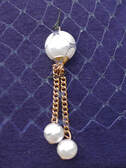 This navy blue pillbox is the last of three hats I inherited from my grandmother, another of the wardrobe basics I talked about in My Grandmother's White Pillbox. It's navy wool with the minimal (but cute) decoration of three pearls. I wore it when my mother was visiting, hoping that she would remember Grandma wearing it. She didn't, unfortunately. She did share other memories with me during her visit, though. One was the story of Grandma looking for work in the Great Depression that I included in My Grandmother's Cello Straw Hat. She also shared memories about her own life. We went to the coast one day, and she told me a story I'd never heard before, about how when she was quite young her family and my Great Aunt Esther's family used to vacation every summer at the beach. They'd get cabins side-by-side and spend a week on the Washington coast. She said it was during the Second World War, and the Americans had deployed troops on the beaches in case the Japanese attacked. The soldiers would whistle at my young, attractive Great Aunt Esther. But my mother's strongest memories were of going clamming. Her parents would wake her and her brother up early, and they'd go out to the beach to dig clams by flashlight. "It was so cold," Mom said, "cold and dark." She doesn't remember having a lot of fun at the beach, just the miserable clamming. Her mother would make clam chowder, but from Mom's tone of voice, she hated the clamming more than she loved the clam chowder. She enjoyed our trip to the ocean where she could bask in the warm October sun, eat a turkey sandwich, and watch the ocean from the bluff, not a clam in sight. Back to The Hat Project main page.
As I wrote in My Grandmother's White Pillbox, I inherited three hats from my grandmother, all what you might call wardrobe basics. I could wear this lined straw hat with almost any dress in my closet. The only hint of the color is in the bow in the back, and I'm not sure if it is a very pale green or simply beige.
The hat body is woven from cello straw and (I think) raffia. Cellophane straw, or cello straw, was an artificial straw quite popular in the 60s. I've never bought a hat made from it--it always seemed odd to me. Artificial straw made from plastic? Why? But I think people liked the hint of shine it lent to summer hats. Also, cello straw is sturdy. Many cello straw hats survived when natural straw might not have. My grandmother would have appreciated durability. My grandmother graduated from teacher's college during the height of the Great Depression. My grandfather, whom she was dating at the time, drove her throughout the area as she tried to find a job. But no one was hiring. After their fruitless search, they decided to get married. At that time, married women were not allowed to teach school (though married men were), so by marrying, she effectively ended her teaching career before it started. On the Sunday I wore this hat, I went home and after lunch taught English online, glad that times have changed, that I could not only work as a young single woman, but as an old married one. When I said I would wear EVERY hat, I wasn’t looking forward to stepping outside the house in some of them. I worried about the Green Feathered Hat and the Birthday Cake Hat, afraid they’d be too over-the-top. I wore those, and it turned out fine. Fun, even. But I dreaded this folded cloth hat with the green veil above all others. My friend Bea passed it along to me after being given it at a garage sale. Yep, it was the other hat in the bag with the White Free-from-a-Garage-Sale Hat. In that post, I described this green veiled hat as “a bit odd.” At first I wondered what had possessed a milliner to make it. Why pair an olive veil with such a weirdly beige off white? Was it made for a specific dress? Then I realize that the hat must have faded drastically over the years. Sure enough, I pulled back the top layer, and underneath were the remnants of a green hat. It looks as if it might have even had multiple shades of green. In fact, this hat might have been pretty cool looking when new. Maybe something like this one on Etsy: But it wasn’t nearly as cool-looking now. However, I said every hat, and I didn’t want to put off wearing this hat till the last, ending The Hat Project with a whimper. So I sucked it up and wore it to church. Maybe I even had it on backwards; I couldn’t tell. In fact, after church I took it off to fix my hair before taking more pictures, and accidentally put it on the opposite way without noticing. People sometimes tell me, “I wish I could wear hats,” or “I don’t look good in hats.” I say that it’s mostly about confidence. If you feel you look good in a hat, you will.
It was hard to be confident in this hat. But I managed. Back to The Hat Project main page. 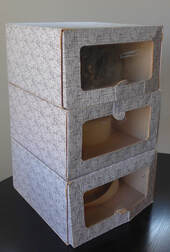 When I was a kid, I noticed three boxes on the shelf in my grandmother’s closet. They had clear plastic windows in the fronts, but I couldn’t see inside. I asked my grandma what was inside them. “Hats,” she told me. By then, hats had gone out of style, and I never saw her wear them. My grandmother’s house was a trove of wonders for me, with its old-fashioned toys (who knew Borden made a board game starring cows Elsie and Elmer (of glue fame)?), its linoleum rug, antique wood-burning cookstove, claw-foot bathtub, and early-20th-century novels in fraying cloth bindings. Hats were the least of it. In fact, I never actually saw them, just their shadows inside those high shelf boxes. Though she had a propane heater and an electric range, on cold mornings Grandma would kindle a fire in the antique kitchen stove against the damp Washington chill. Sundays she walked to the church on the corner. We kids would set up the croquet set on her mossy lawn and she’d play with us. She grew hollyhocks next to her back porch. She skipped rocks. A river ran through town, spanned by a wooden train trestle, and she’d walk with us down to the river, where the trestle’s creosote smell blended with the smell of damp sand and snake grass. In fact, though I have other pictures where she’s dressed more formally, this picture of her at the river is my favorite. Maybe you can tell from the photo that she had a sparkle in her eyes, signaling her stealth sense of humor. I miss her. Her birthday fell in September, and I always especially remember her this time of year. After Grandma died, my mother gave me Grandma’s hats. “We thought these should go to you,” she said, handing me the three boxes that I’d forgotten until I saw them again, their hats still hidden in the shadows. I’m not sure what I expected—Grandma wasn’t rich and didn’t go in for extravagant display. When I finally saw them, the hats themselves were relatively plain. Wardrobe basics that she could wear with a lot of different outfits. I put them away. They went from her closet shelf to mine. When I started this project, I knew I would finally wear those three hats. But I kept hesitating. What did I want to say about her? How could I convey the person she was? Then I got the pie dress. I saw this dress online and, feeling as I do about pie (HUGE fan), I bought it. Grandma was famous for her pies. We looked forward to them every time we came to visit—wild blackberry and, especially, apple pies made from the yellow transparent apples she grew—soft, early ripening apples that cooked down into wonderful applesauce and pies. So it felt right, in this, her birth month, in the pie dress, to finally wear one of her hats and write about her. And, if I didn’t say everything I want to say about her, well, I have two more hats to go. Here’s a close-up of the hat. It’s white faux fur, its veil slightly misshapen from its years in the hatbox. My guess it it’s been 50 years since anyone wore this hat. I was proud to wear it, in honor of Grandma. Return to The Hat Project main page.
One evening at a Peninsula Women’s Chorus rehearsal, my friend Bea came up to me. “I saw a couple of hats at a garage sale this weekend. Since it was at the end of the day, they gave them to me for free. I thought maybe the JewelTones could use them.” And she handed me a bag.
A bag like this is Christmas for me. I peeped inside. I immediately knew one hat would never work for the JewelTones, whose 1940s costumes have an overall color scheme of black, white, gray, and red. That hat had a green veil. It was also, as you’ll see eventually, a bit odd. But the other hat was a JewelTones possibility, since it was white. It had a cute shape akin to a backwards S. However, it struck me as more of a 50s hat than a 40s hat. I decided to keep the green veil hat and ask the JewelTones about the white hat. At the next JewelTones rehearsal, I mentioned that Bea had given us a white hat. Could we use it? To my delight, no one piped up that they needed a new costume hat. Like the Birthday Cake hat, when these hats didn’t work for the JewelTones they entered my collection. Hats, as you’ve guessed, are a kind of obsession with me. I’m not quite trustworthy around them. In addition to its cute curlicue shape, the workmanship on this hat is intricate, as you can see from the closeup. It was made by Clover Lane, a pretty prolific maker of hats back in the day, if Etsy is any guide. I’ve never worn this hat before, though I’ve been meaning to for a while. I thought it would look cute with the blue retro dress I wore with the Madame X hat, but when I tried it, it just didn't go with the dress. So, a black hat with that dress, and a different outfit for this one. |
AuthorAnn Hillesland writes fiction and nonfiction and collects hats. In this blog she vows to wear (not just model, but wear out of the house) every one of her hats, blogging about their histories and their meanings for her. Archives
March 2024
Categories |
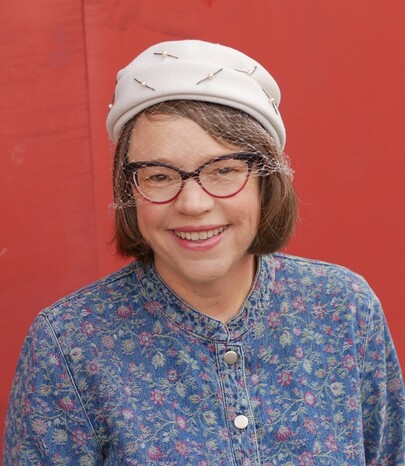
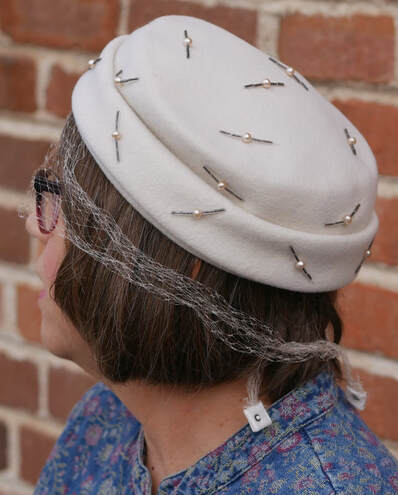
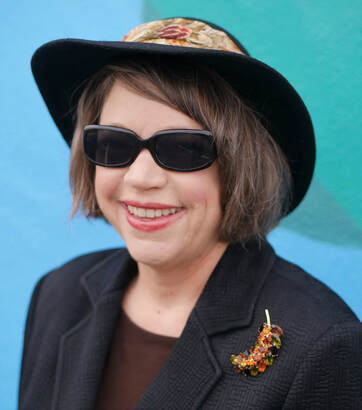
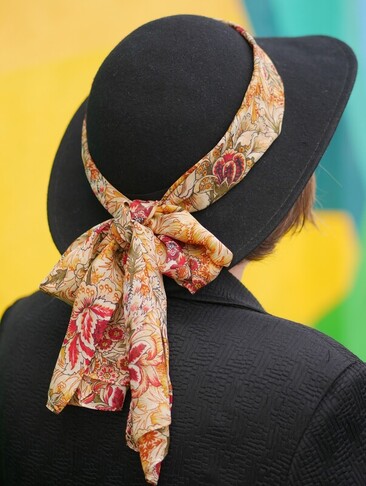
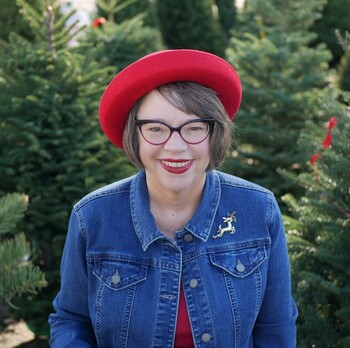
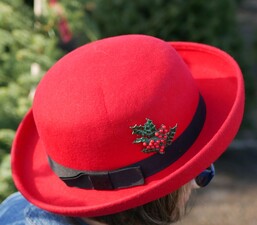
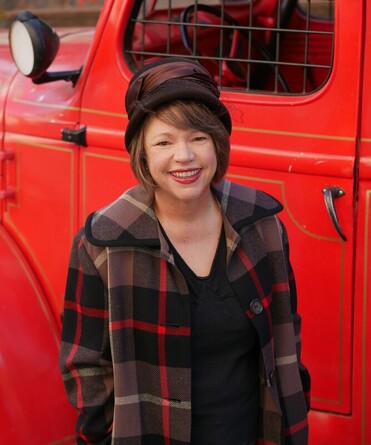
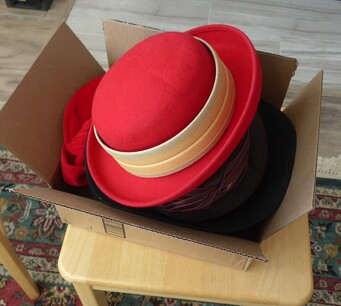
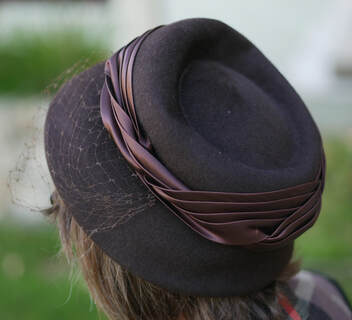

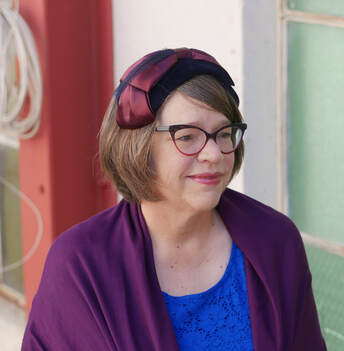
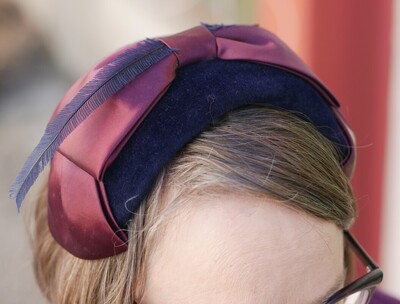
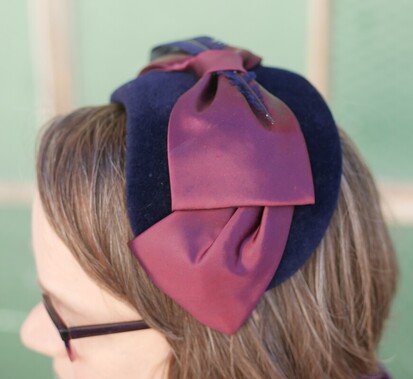
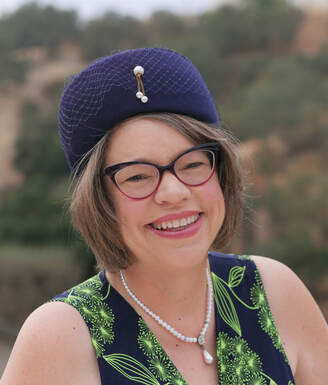
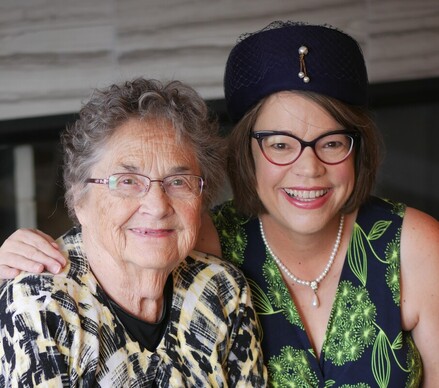
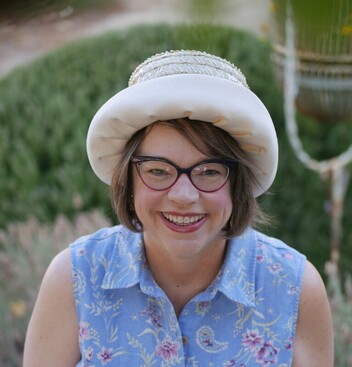
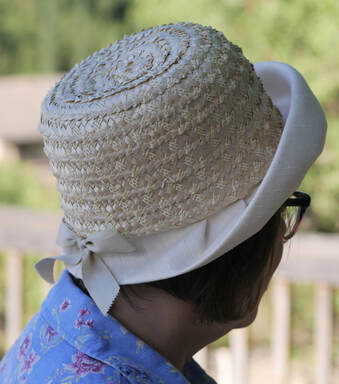
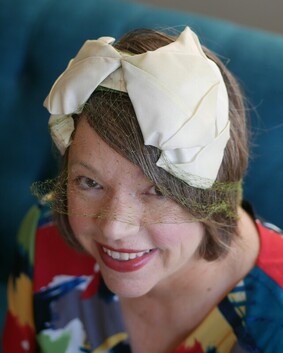
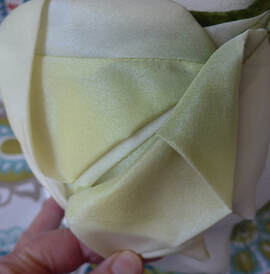
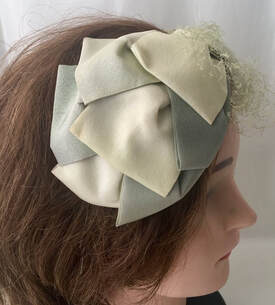
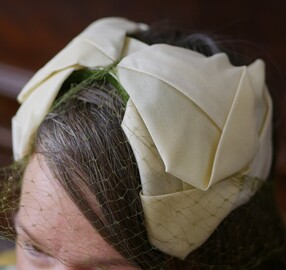
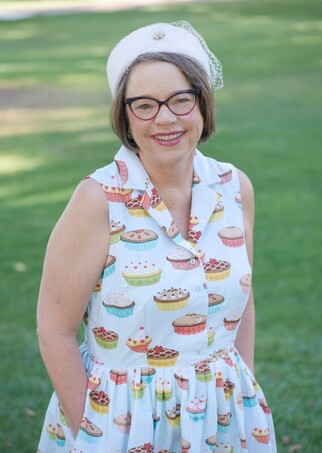
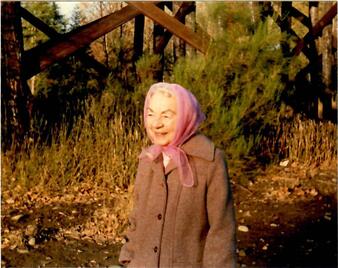
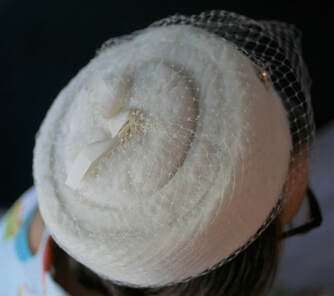
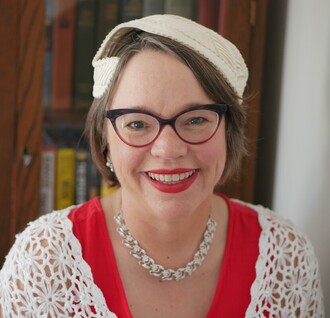
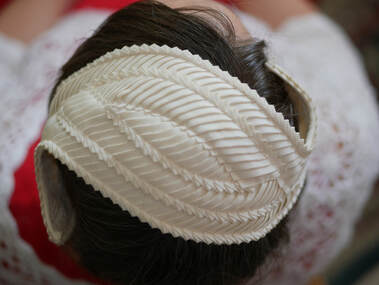
 RSS Feed
RSS Feed